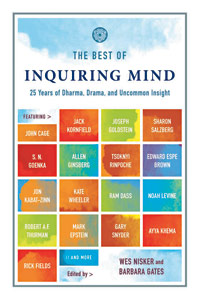The Best Of Inquiring Mind: 25 Years Of Dharma, Drama, And Uncommon Insight
Edited By Wes Nisker And Barbara Gates
Boston: Wisdom Publications, 2008
400 pp.; $17.95 (paper)
From the very beginning, the semiannual Vipassana journal Inquiring Mind promised a looser, more eclectic approach to Western Buddhism. The name itself is a clue. It elegantly encapsulates the essence of insight meditation. But it’s also a sly reference to the supermarket tabloid the National Inquirer, whose slogan back in the day was “Inquiring minds want to know.” That same blend of devotion and irreverence runs throughout this collection of interviews, articles, and poetry from Inquiring Mind’s 25- year history. The results are profound and entertaining, a highly readable time capsule from an extraordinary quarter century of North American Buddhism.

Coeditors Wes Nisker and Barbara Gates—who cofounded the journal—have structured The Best of Inquiring Mind by topic, rather than chronologically. Sections include “Path of the Elders,” “Living & Dying in a Body,” “Science of Mind” (what is this thing that thinks?), and ordinary life as experienced by Buddhists (“The Dharma & the Drama”). “Complementary Paths” explores non-Vipassana Buddhism and Advaita Vedanta, “Practices” concerns meditative techniques, and “Tending to the World” addresses social and environmental concerns. “Artists & Jesters of the Dharma” focuses on Buddhist-influenced writers and artists like Jack Kerouac and the musician John Cage, while also exploring poetry, parody, and the Tibetan “crazy wisdom” tradition.
What struck this reader first were some remarkable lines from the interviews, such as S. N. Goenka’s statement “I believe only in Dhamma. For me Hinduism and Buddhism are both madness.” Or Joseph Goldstein’s description of the universal love that comes with realization as “not articulated; you don’t go around saying, ‘I love you, hand.’” Or Tsoknyi Rinpoche’s explanation of why Dzogchen teaching is good for Americans: “Everything here is considered too real, too serious, and because you think everything is very real you get crazy. You have a ‘real’ problem.”
Then there are the koan-like gems offered by a five-year-old girl when poet Judith Stronach, inspired by Pablo Neruda’s Book of Questions, suggested that she think of some really hard questions. The young sage came up with posers like “How did glass become breakable?” and “How did darkness get made?” And her last and hardest question: “How did there get to be the first thing?” (Yep. That’s the question, all right.)
It’s entertaining when Wes Nisker tries to get Advaita Vedanta teacher Hari Lal Poonja—”Poonja-ji” to his devotees—to answer some questions, and the jnani insists on posing his own instead, such as “Who is asking this question?” The interview winds up sounding like the message a truly egoless being might leave on an answering machine: The person you believe to exist is not present right now, but please leave a message indicating who you think it is who has placed this call.
Other pleasures include Gary Snyder’s comparison of today’s North American Buddhism with that of fourth-century China, and his invocation of a future American practice that is “more open and more T’ang Chinese … [with] old women trading insults and teacakes with wandering monks … a Ch’an for ordinary people and a few ghosts and spirits thrown in.” Then there’s Allen Ginsberg, raising the possibility of Westerners reintroducing an “essential, active, muscular form of meditation to China.” There’s Santikaro, an American-born Thai Buddhist monk, on breathing. And Francisco Varela’s brilliant insights on Buddhism and cognition. Joseph Goldstein’s two interviews demonstrate his uncompromising embrace of Buddhist cosmology and metaphysics, which contrasts with more therapeutically-inclined interpretations of the dharma.
Then there’s the conversation between Wes Nisker and Noah Levine, founder of the Dharma Punx movement. Levine, true to his punk origins, confronts the older teacher with the comment that his generation can’t afford to pay for Vipassana retreats: “If you had to pay the prices you are now charging at your retreat centers back when you were starting to practice, you couldn’t have afforded them either.”
But that’s as close to conflict as this book gets. At the opposite end of the emotional spectrum, Miranda Shaw emphasizes that intimacy rather than lascivious sex is the essence of tantric couples practice. (She describes, for example, staring into your partner’s eyes for hours to see the divine in one another.) Ayya Khema explores the stages of jhana (meditative absorption) practice, and two Native Americans discuss with Tibetan Buddhist teacher Tsultrim Allione similarities between Buddhist and indigenous practices. Further gratifying insights are offered by Jack Kornfield, Ajahn Amaro, Sharon Salzberg, Jon Kabat-Zinn, Joanna Macy, and others.
If a given chapter doesn’t grab you, no problem. Turn the page, and there will be something completely different. That’s the strength of this collection, which is both enjoyable and enlightening.
Thank you for subscribing to Tricycle! As a nonprofit, we depend on readers like you to keep Buddhist teachings and practices widely available.